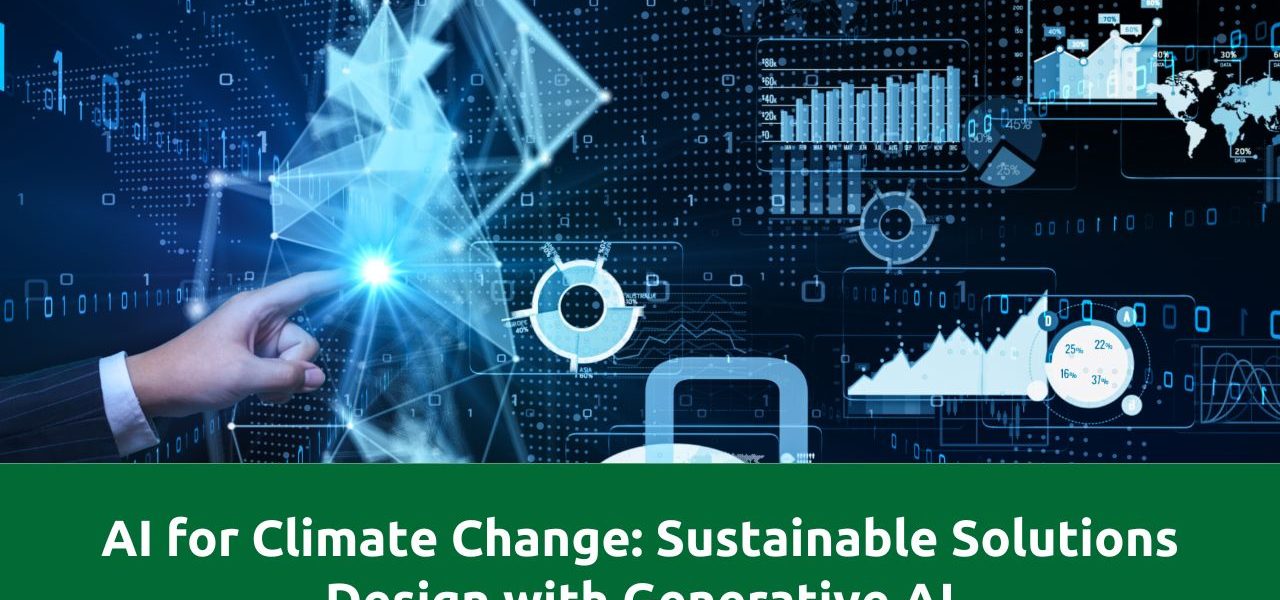The urgency of addressing climate change demands innovative solutions. Generative AI, a branch of artificial intelligence (AI) focused on creating entirely new data, emerges as a powerful tool in this fight. By generating novel materials, optimizing renewable energy systems, and designing sustainable infrastructure, generative AI can play a significant role in building a more sustainable future.
The Power of Generative AI: Creating Solutions from Scratch
Generative AI algorithms learn from massive datasets, identifying patterns and relationships. This knowledge allows them to create new content, including images, text, and even 3D models. In the context of climate change, generative AI offers unique functionalities:
- Material Discovery: Developing sustainable materials is critical for a green transition. Generative AI can analyze material data and identify promising candidates with desired properties. Imagine generating new bioplastics with superior strength or biodegradable building materials for eco-friendly construction.
- Climate Modeling Enhancement: Generative AI can create more complex and accurate climate models. These models can simulate future climate scenarios under various conditions. This allows scientists to predict the impact of climate change with greater accuracy and inform mitigation strategies.
Example:
A generative AI model trained on historical climate data and greenhouse gas emission projections can simulate future weather patterns with higher precision. This information helps policymakers develop targeted adaptation plans for regions most vulnerable to extreme weather events.
- Renewable Energy Optimization: Generative AI can optimize the design and placement of renewable energy infrastructure, such as solar panels or wind turbines. This can maximize energy production and efficiency. Imagine an AI model that analyzes wind patterns and terrain data to identify optimal locations for wind farms, maximizing electricity generation from wind power.
Example:
A generative AI solution can analyze a specific geographical area and suggest the most efficient layout for a solar panel array, considering factors like sun exposure and shading to maximize energy output.
- Smart Grid Management: Generative AI can be used to develop intelligent algorithms for managing smart grids, integrating renewable energy sources with traditional power grids. This allows for a more balanced and efficient energy distribution system. Imagine an AI system that dynamically adjusts energy flow based on real-time data on energy production and demand, optimizing grid stability and reducing reliance on fossil fuels.
Custom Generative AI Solutions for Tailored Climate Action
Generative AI solutions aren’t one-size-fits-all. The specific challenges and needs vary across industries and regions. Custom generative AI solutions developed by specialized firms offering generative AI development services can address these nuances.
- Industry-Specific Applications: Imagine a custom generative AI solution for the fashion industry that develops sustainable, high-performance fabric alternatives to traditional materials with a large environmental footprint.
- Regional Climate Action: A custom solution can analyze data specific to a particular region, identifying areas most susceptible to rising sea levels or drought. This information can guide local governments in developing targeted adaptation strategies.
Challenges and Considerations for Generative AI in Climate Solutions
While generative AI offers vast potential, challenges exist:
- Data Quality and Bias: Generative AI models rely on the quality and completeness of training data. Biased data can lead to biased solutions. Careful data selection and curation are crucial to ensure reliable results.
- Computational Cost: Training generative AI models requires significant computing power, which can be expensive and energy-intensive. Developing sustainable and efficient computing solutions is essential for broader adoption.
- Explainability and Transparency: Understanding how generative AI models arrive at their outputs is crucial for trust and adoption in critical areas like climate action. Explainable AI techniques are needed to ensure transparency in decision-making.
Implementing Generative AI Solutions for Climate Change: A Roadmap
Here’s a roadmap for implementing generative AI solutions for climate change:
- Define the Challenge: Identify the specific climate change issue you want to address with generative AI. Is it material discovery for sustainable construction or optimizing renewable energy production in a specific region?
- Data Collection and Preparation: Gather relevant, high-quality data to train the generative AI model. Partner with domain experts to ensure data is comprehensive and unbiased.
- Partner with Generative AI Experts: Collaborate with data scientists and AI specialists who can develop and train a custom generative AI model for your specific needs.
- Pilot Projects and Validation: Start with small-scale pilot projects to test the effectiveness of your solution. Refine the model based on results obtained during these pilot phases.
- Scalability and Integration: Plan for scaling the solution for a larger impact. Consider integration with existing systems and infrastructure to facilitate wider adoption.
The Role of Technology Partners and Collaboration
Successfully implementing generative AI solutions for climate change requires a collaborative approach.
Technology partners with expertise in generative AI development services can play a vital role in this process. These companies can:
- Assess Needs and Feasibility: Help assess if a generative AI solution is the best approach for your specific climate change challenge.
- Develop Custom Solutions: Design and develop custom generative AI models tailored to your unique needs and data sets.
- Provide Ongoing Support: Offer ongoing support for model maintenance, training, and integration with existing systems.
Collaboration is also crucial. Scientists, engineers, policymakers, and businesses must work together:
- Scientists and Engineers: Provide domain expertise and data to train generative AI models.
- Policymakers: Develop regulations and incentives to encourage the development and adoption of generative AI solutions for climate action.
- Businesses: Invest in generative AI solutions and integrate them into their operations to reduce their environmental footprint.
Examples of Collaboration in Action
- Public-Private Partnerships: Governments can partner with private companies to develop and deploy generative AI solutions for climate change. Imagine a collaboration between a government agency and an AI company to develop a generative AI model that helps optimize energy efficiency in public buildings.
- International Cooperation: The challenges of climate change are global. International collaboration between research institutions, technology companies, and governments is crucial for developing and scaling generative AI solutions with a global impact. Imagine an international consortium developing a generative AI model to predict and mitigate the impacts of extreme weather events around the world.
Conclusion: A Sustainable Future Through Generative AI
Generative AI offers a powerful tool in the fight against climate change. By generating new materials, optimizing renewable energy systems, and designing sustainable infrastructure, generative AI can help us build a more sustainable future. However, successful implementation requires overcoming challenges, developing custom solutions, and fostering collaboration between various stakeholders. Through a collaborative effort, we can leverage the power of generative AI to create a healthier planet for generations to come.





